Atmospheric Water Generator Market Research, 2033
The global atmospheric water generator market size was valued at $2.7 billion in 2023, and is projected to reach $10.8 billion by 2033, growing at a CAGR of 14.8% from 2024 to 2033. Atmospheric water generator is also known as a hydro-panel device that extracts water from moisture & humid ambient air and produces potable water. Water vapor in the air can be extracted with the help of technologies such as cooling condensation and wet desiccation. Atmospheric water generators (AWGs) are useful where portable water is not easy to obtain as water is present in nearby ambient air.
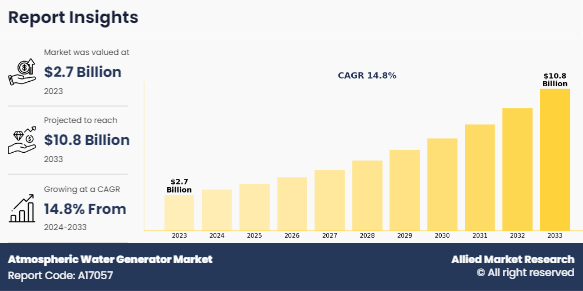
Report Key Highlighters
• The Atmospheric water generator market analysis studies more than 23 countries. The analysis includes a country-by-country breakdown analysis in terms of value ($million) available from 2023 to 2033.
• The research combined high-quality data, professional opinion, and research, with significant independent opinion. The research methodology aims to provide a balanced view of the global market, and help stakeholders make educated decisions to achieve ambitious growth objectives.
• The research reviewed more than 3,700 product catalogs, annual reports, industry descriptions, and other comparable resources from leading industry players to gain a better understanding of the market.
• The Atmospheric water generator market share is marginally fragmented, with players such as PLANETSWATER, Ecoloblue, Quench Innovations, SkyWater Air Water Machines, Water Technologies International, Inc., Drinkable Air Technologies, Atlantis Solar, Clean Wave Products, GENAQ, Watergen, Eshara Water, Akvo Atmospheric Water Systems Pvt. Ltd, DewPoint Systems, Mayaqwa, AERONERO, Air 2 Water Solutions, FUJIAN WANJUAN TECHNOLOGY CO.,LTD,. Major strategies such as product Launch, partnerships, expansion, and other strategies of players operating in the market are tracked and monitored.
Market dynamics
Water scarcity is an escalating global issue, affecting both developed and developing nations. The United Nations reports that approximately 2.2 billion people lack access to safely managed drinking water services. Climate change exacerbates this problem by altering precipitation patterns and reducing the availability of freshwater resources. The World Bank estimates that by 2025, half of the world’s population will be living in water-stressed areas. For instance, nearly 600 million people in India face high to extreme water stress, according to the NITI Aayog. In the United States, over 40% of the population relies on groundwater for drinking, which is being depleted faster than it can be replenished, as indicated by the U.S. Geological Survey (USGS). These statistics highlight the urgent need for alternative water sources like atmospheric water generators (AWGs), which can extract water from humid air and provide a reliable supply of potable water, addressing the growing global water scarcity.
Moreover, government-led initiatives are playing a crucial role in encouraging the development and adoption of atmospheric water generators (AWGs), serving as a significant driver for the market. Various governments worldwide are recognizing the importance of sustainable water solutions and are implementing policies and programs to support AWG technology. For instance, India’s Jal Shakti Abhiyan, launched in 2019, focuses on water conservation and includes promoting AWGs in water-scarce regions. In the United States, both federal and state governments have introduced incentives and grants to support AWG development, with the Department of Energy funding R&D projects and states like California offering rebates for adopting water-saving technologies. Similarly, Israel has integrated AWGs into its national water efficiency programs, providing funding and support for companies developing this technology and implementing pilot projects in arid regions. These initiatives provide financial support, regulatory frameworks, and public awareness, fostering the growth of the AWG market and encouraging sustainable water practices.
However, the Atmospheric Water Generator Market Growth is being constrained by high product costs, particularly in applications for homes and small businesses. A medium sized atmospheric water generator that produces more than 1000l/day cost $30,000 to $50,000. In addition, a consistent supply of electricity must be available for these systems to function effectively. As a result, the overall cost of the operation goes up. However, it is anticipated that as new technologies are adopted, the price and impact of these limiting factors will decline during the forecast period. Therefore, this is an important factor that is expected to curb the growth of the atmospheric water generator market.
Moreover, a major Atmospheric Water Generator Market Opportunity includes technological advancements in AWGs that can foster market growth. Technological advancements have significantly improved the efficiency and cost-effectiveness of atmospheric water generators (AWGs). Innovations in materials science, thermodynamics, and energy sources have led to the development of more efficient water extraction processes. For example, integrating solar panels with AWGs allows for energy-independent operation, making them suitable for remote and off-grid locations. Modern AWGs can produce up to 20 liters of water per day from the air with relative humidity levels as low as 30%. Energy consumption has also decreased, with newer models requiring approximately 0.2-0.3 kWh per liter of water produced, compared to up to 0.5 kWh per liter for earlier models. The global market for solar-powered AWGs is experiencing substantial growth, with projections indicating a compound annual growth rate (CAGR) of over 25% from 2021 to 2028. These technological improvements enhance the accessibility and practicality of AWGs, driving market growth.
Segmental Overview
The market is segmented on the basis of type, capacity, application, and region. On the basis of type, the market is divided into cooling condensation and wet desiccation. By capacity, the market is divided into up to 60 liters, 61-500 liters, 501-1000 liters, and more than 1,000 liters. On the basis of application, the market is divided into residential and non-residential. Region-wise, the market analysis is conducted across North America, Europe, Asia-Pacific, and LAMEA.
By type, the atmospheric water generator market is divided into cooling condensation, and wet desiccation. In 2023, cooling condensation segment held the largest market share in terms of revenue. On the other hand, wet desiccation is anticipated to grow with a higher CAGR during the forecast period. Cooling condensation is a process used in atmospheric water generators (AWGs) to extract water from the air. It involves cooling humid air to below its dew point, causing the water vapor to condense into liquid water. Cooling condensation is one of the most common and efficient techniques employed in AWGs to produce potable water from atmospheric humidity.
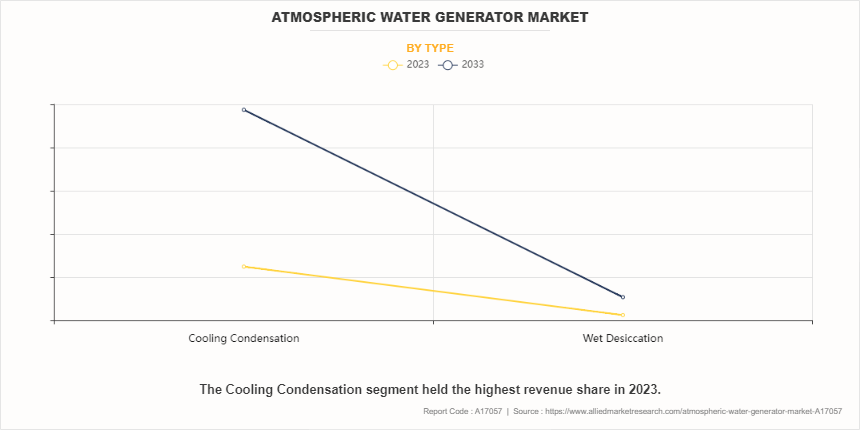
By capacity, the market is categorized into up to 60 liters, 61-500 liters, 501-1000 liters, and more than 1,000 liters. In 2023, 61-500 litres segment held the largest market share in terms of revenue. This segment analyses the sales generated by atmospheric water generators having water generating capacity ranging from 61 to 500 liters in 24 hours. These AWGs are commonly installed in small residential communities as well as in institutional and commercial locations such as schools, hospitals, malls, and others. Growth in atmospheric water generator is due to the growing investment by the government on the public sector projects. In addition, the tourism industry is growing in the country, which is driving the construction infrastructure industry in the country. Owing to this, various atmospheric water generator manufacturing companies are increasing their production and capacity to meet rising demand for water. Hence this will drive the demand for the atmospheric water generator. This in turn is expected to drive the growth of the market. However, the Upto 60 litres segment is expected to grow with a higher CAGR during the forecast period. Atmospheric water generator (AWG) with capacity less than 60 liters are primarily demanded by homes or small offices. In addition, portable atmospheric water generators are also bought by a considerable number of consumers to harvest water from the atmosphere especially when they are traveling.
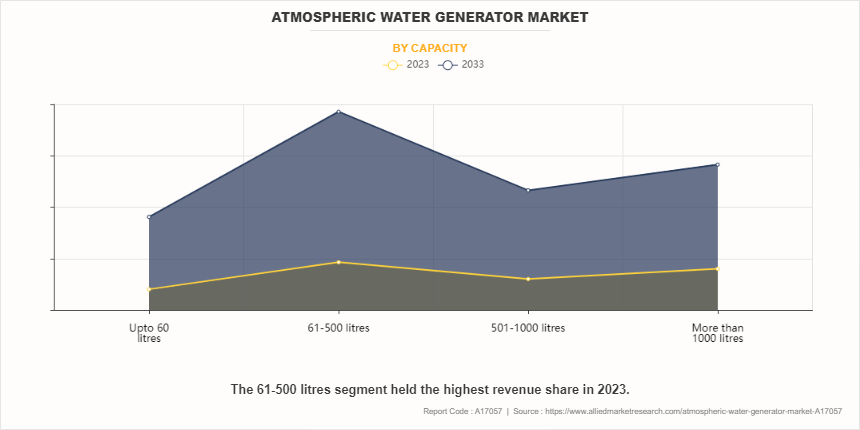
By application, the Atmospheric water generator market is categorized residential and non-residential. In 2023, non-residential segment held the largest market share in terms of revenue. On the other hand, residential segment is anticipated to grow with a higher CAGR during the forecast period. In non-residential settings, such as industries ranging from agriculture to healthcare, Atmospheric Water Generators (AWGs) are increasingly sought after for their versatile benefits. These systems ensure a consistent and reliable water supply independent of municipal infrastructure, crucial for operations in areas prone to water scarcity or unreliable utilities. Cost efficiency plays a pivotal role, particularly in high-water-consumption sectors like manufacturing, where AWGs can reduce expenses associated with water purchase and treatment. Moreover, AWGs align with corporate sustainability objectives by minimizing reliance on bottled water and reducing carbon footprints. Their deployment enhances operational flexibility, especially in remote or temporary locations, and ensures compliance with stringent water quality standards in industries where purity is paramount, such as healthcare facilities. In emergencies, AWGs serve as a resilient backup, providing safe drinking water when conventional sources may be compromised. This multifaceted appeal underscores AWGs as a strategic investment for enhancing resilience, sustainability, and operational efficiency across diverse non-residential environments.
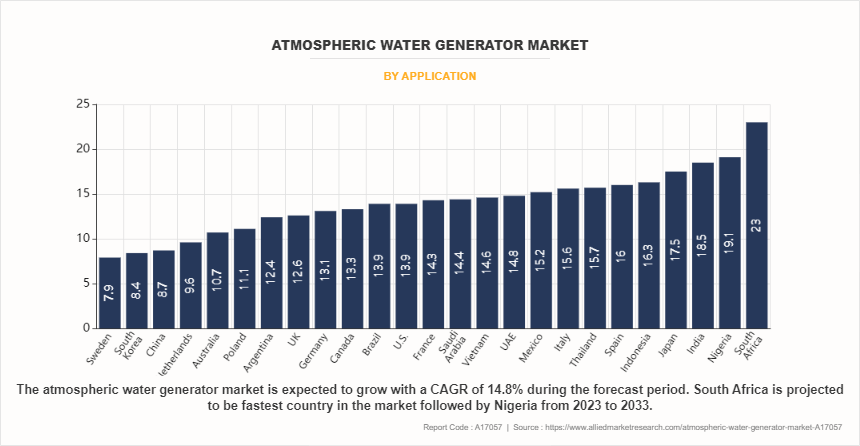
By region, the Atmospheric water generator market is analyzed across North America, Europe, Asia-Pacific, and LAMEA. In 2023, Asia-Pacific had the highest market share and is anticipated to secure the leading position during the forecast period. Inefficient water supply infrastructure is a common occurrence in many countries of the region, including India, China, the Philippines, and many. Not only inefficient infrastructure but also unhygienic water supply in many places has led to the search for alternatives for freshwater supply. Thus, in many locations of Asia-Pacific public and private entities are installing AWGs.
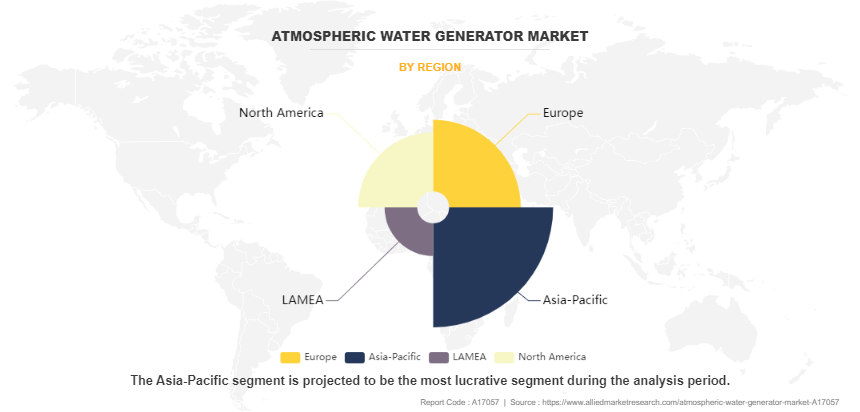
Competition Analysis
Competitive analysis and profiles of the major players in the PLANETSWATER, Ecoloblue, Quench Innovations, SkyWater Air Water Machines, Water Technologies International, Inc., Drinkable Air Technologies, Atlantis Solar, Clean Wave Products, GENAQ, Watergen, Eshara Water, Akvo Atmospheric Water Systems Pvt. Ltd, DewPoint Systems, Mayaqwa, AERONERO, Air 2 Water Solutions, FUJIAN WANJUAN TECHNOLOGY CO.,LTD., are provided in the report. Major players have adopted product launch and acquisition as key developmental strategies to improve the product portfolio of the Atmospheric water generator market.
Recent Development in the Atmospheric water generator Market
- In April 2021, Water Zone, Inc., subsidiary of Water Technologies International, Inc. announced that it has signed an agreement with a manufacturer of a whole house reverse osmosis systems to be sold in a national chain of "Big Box" home improvement stores throughout Florida
- In May 2022, A team of CSIR-IICT scientists, led by Chief Scientist S. Sridhar, recently installed fifteen Atmospheric Water Generator (AWG) units in remote community schools and colleges in Dehradun, Rishikesh, and Tehri districts of Uttarakhand, where groundwater is scarce. The installation includes ten units with a capacity of 60 liters per day and five units with a capacity of 150 liters per day.
Key Benefits for Stakeholders
- The report provides an extensive analysis of the current and emerging Atmospheric water generator market trends and dynamics.
- In-depth market analysis is conducted by constructing market estimations for the key market segments between 2023 and 2033.
- Extensive analysis of the Atmospheric water generator market is conducted by following key product positioning and monitoring of the top competitors within the market framework.
- A comprehensive analysis of all regions is provided to determine the prevailing opportunities.
- The Atmospheric water generator market forecast analysis from 2024 to 2033 is included in the report.
- The key market players within Atmospheric water generator market are profiled in this report and their strategies are analyzed thoroughly, which help understand the competitive outlook of the Atmospheric water generator industry.
Atmospheric Water Generator Market Report Highlights
| Aspects | Details |
| Market Size By 2033 | USD 10.8 billion |
| Growth Rate | CAGR of 14.8% |
| Forecast period | 2023 - 2033 |
| Report Pages | 352 |
| By Type |
|
| By Capacity |
|
| By Application |
|
| By Region |
|
| Key Market Players | Air 2 Water Solutions, Watergen, Drinkable Air Technologies, DewPoint Systems, Mayaqwa, SkyWater Air Water Machines, Water Technologies International, Inc., Atlantis Solar, Akvo Atmospheric Water Systems Pvt. Ltd., GENAQ, Eshara Water, AERONERO, QUENCH INNOVATIONS, FUJIAN WANJUAN TECHNOLOGY CO., LTD., Clean Wave Products, PLANETSWATER, Ecoloblue |
Analyst Review
According to insights of CXOs of leading companies, the atmospheric water generator (AWG) market has observed huge demand in North America, Asia-Pacific, and Europe. Asia-Pacific is projected to remain the major revenue-generating region of the market in the near future, owing to rapidly rising population, and increasing water scarcity. In addition, many regions in Asia-Pacific have high humidity that can be harnessed to generate atmospheric water.
Advanced technology is used in AWG to create potable water from the ambient air and humidity around it. This offers the chance to increase the amount of water that is available during shortages and contaminant occurrences that can cause drinking water services to be interrupted. The demand for automatic water generators has increased due to rise in need for safe water. Moreover, it can overcome water problems such as public water infrastructure failures and pipe corrosion causing pollution concerns.
Various market players are adopting strategies such as product launches, business expansion, acquisitions, partnerships, and agreements to expand their business and strengthen their market position. For instance, in May 2022, Drinkable Air Technologies partnered with Green Key, which is an international eco-label for tourism facilities. Through this partnership, the company focused to reduce water consumption and disposal of plastic water bottles. Furthermore, company partnered with ARATA International FZC, which is expected to be the new exclusive partner in the UAE & Oman for the distribution of drinkable air technology products. As a result, such strategic moves are expected to provide lucrative growth in the global atmospheric water generator market.
Increasing water scarcity, various government-led initiatives, and rising awareness and environmental concerns drive the growth of the global atmospheric water generator market.
The latest version of the Atmospheric water generator market report can be obtained on demand from the website.
The Atmospheric water generator market size was valued at $ 2,733.8 million in 2023.
The Atmospheric water generator market size is estimated to reach $10,823.5 million by 2033, exhibiting a CAGR of 14.8% from 2024 to 2033.
The forecast period considered for the atmospheric water generator market is 2024 to 2033, wherein, 2023 is the base year, 2024 is the estimated year, and 2033 is the forecast year.
Non-residential segment is the largest market for Atmospheric water generator market.
Key companies profiled in the Atmospheric water generator market report PLANETSWATER, Ecoloblue, Quench Innovations, SkyWater Air Water Machines, Water Technologies International, Inc., Drinkable Air Technologies, Atlantis Solar, Clean Wave Products, GENAQ, Watergen, Eshara Water, Akvo Atmospheric Water Systems Pvt. Ltd, DewPoint Systems, Mayaqwa, AERONERO, Air 2 Water Solutions, FUJIAN WANJUAN TECHNOLOGY CO.,LTD.
The report contains an exclusive company profile section, where leading companies in the market are profiled. These profiles typically cover company overview, geographical presence, market dominance (in terms of revenue and volume sales), various strategies, and recent developments.
Loading Table Of Content...
Loading Research Methodology...


